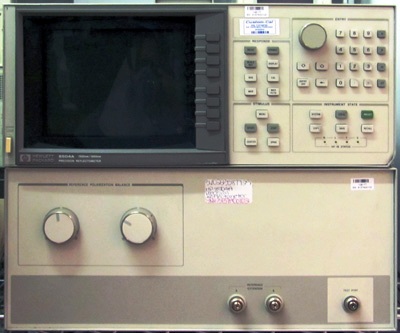
|
|
The HP 8504A precision reflectometer is an optical instrument for making precise return-loss and back reflection measurements using sm 9/125 micrometer fiber. Measurements are applicable to all typical lightwave components such as opto-isolators, microphotonic assemblies, couplers, amps and connectors. The 8504A contains two internal wavelength sources (1300 and 1550 nm), both with 60 nm of spectral width. The peak wavelength for the 1300 nm source can occur at +/- 30 nm to source wavelength. The 1550 nm source peak wavelength occurs at 1550 +/- nm. Return loss measurements can be made with both source wavelengths. The power level range for the 1300 nm source is 0 to 75 dB, and 0 to 65 dB for the 1550 nm source. Return loss measurements can be made to an accuracy of +/- 2 dB, with a repeatability of +/- 1 dB. The 8504A is able to resolve closely-spaced reflections down to 17 micrometers for wavelengths of 1300 nm, and 34 micrometer for wavelengths of 1550 nm. With a measurement distance of 1 to 10 mm, two-event spacial accuracy is +/- 2% of span, and +/- 0.5% of span for distances of 10 to 400 mm. The 8504A offers low levels of spurios responses, with a spurious level at -40 dBc in high sensetivity, and -60 dBc in low sensetivity. Sweep speed is 17.9 mm/s or 0.056 s/mm. The full measurement span is 1 to 400 mm, which can be extended by using supplied fiber extension links. There are seven options available for order with the unit. These include 210 and 220, the ability to remove the internal 1300 and 1550 nm sources respectively. There are five available connector types for both front panel connectors and extension cables: opt 011 (HMS-10/HP), 012 (FC/PC), 013 (DIN 47256), 014 (ST), and 015 (Biconic).
|